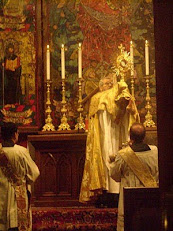January 20, 2009
by Joseph Shaw
[Note: Fr. Saward will be one of the speakers at the 2009 Anglican Use Society Conference to be held June 11-13 in Houston, Texas.]
(For a previous post on Fr Saward, who is a widely published theologian, in the NLM see here; for the parish website, with more photographs of the church including what it looked like before the restoration, see here.)
Fr John, can you tell us a little about the history of the church, and what it was like when you became Priest in Charge?
The parish of SS. Gregory and Augustine – traditionally called “St Gregory’s” for short – was established in 1912. It lies to the north of the Oratorian parish of St Aloysius, and includes in its boundaries the village of Wolvercote. St Gregory’s has many literary connections: former parishioners include Graham Greene, the poet Elizabeth Jennings, and J. R. R. Tolkien; Monsignors Ronald Knox and Vernon Johnson also came here as visiting preachers...
Read in full at The New Liturgical Movement blog.
Obituary of a very failed Pontificate
-
"Nun khre methusthen kai tina per bian ponen, epei de katthane
Mursilos."Such would have been the reaction of the unchristianised Greeks.
But for us, for t...
5 months ago














No comments:
Post a Comment